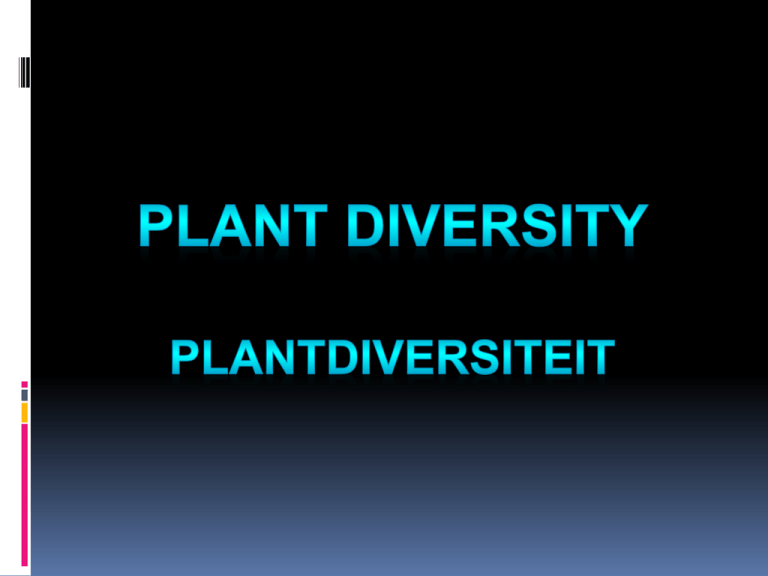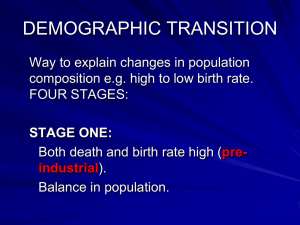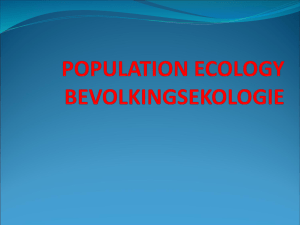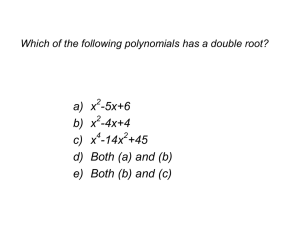
Grassland (28.9%)
Nama-Karoo(20.6%)
Albany Thicket (2.8%)
Succulent Karoo (6.9%)
Savannah (33.2%)
Desert (0.6%)
Forests (0.4%)
Fynbos (6.6%)
Taxa (groups of
species)
Number of known Species
South Africa
World
South African
Species as % of
earth’s known
species
Mammals
295
5.8%
Birds
880
8.0%
Amphibians
110
2.1%
Reptiles
286
4.6%
Freshwater fish
220
1.3%
Marine fish
2150
16.0%
Insects
80 000
5.5%
Vascular plants (e.g.
flowering plants,
conifers, cycads and
ferns
23 420
7.5%
ENDEMIC: when a species is only found in
ONE specific area or habitat in the world
SA = 5th -richest country in Africa
SA = 24th-richest in the world
3 Hotspots:
1. SUCCULENT KAROO
2. FYNBOS
3. MAPUTALAND-PONDOLAND-ALBANY
Species and ecosystem diversity ensures the
health of our planet.
Loss of biodiversity leads to unstable
ecosystems
Also the loss of clean water, fresh air , food
and medicines.
HUMAN ACTIVITIES contribute to loss of
species 100 to 1000 times faster than before
Worldwide = we’re losing 70 species a day.
HABITAT DESTRUCTION
Cutting down indigenous forests
Filling in wetlands
Damming up rivers
Clearing land for new settlements
When species lose habitats …..
They are deprived of food and shelter
Isolated from others – leads to in breeding
(loss of genetic diversity)
HUMAN POPULATION GROWTH
Increased demand on energy, food,
minerals
Using more land, water, trees, fossil
fuels. Minerals, plants and animals
Increased usage – devastating effects
on biodiversity
Climate change (global warming)
AGRICULTURAL ACTIVITY
Indigenous, natural vegetation is cleared
for cultivation and afforestation
Wetlands are filled to create more land
for farming
Overgrazing destroys natural vegetation
Results in soil erosion
INDUSTRY AND MINING
Industries pollute water, air and soil
Destroy natural habitats
Timber industry – loss of habitat for
wildlife
Trade in wildlife- rhino horn, buchu
Invasive species (black wattle)
Food and medicine for everyone
Aesthetic value
Tourism potential
Bryophytes (e.g. Mosses)
Pteridophytes (e.g. Ferns, horsetails)
ORIGIN OF
PLANTS
EARLY
VASCULAR
PLANTS
FIRST SEED
PLANTS
Gymnosperms (e.g. Conifers, Cycads)
RADIATION OF
FLOWERING
PLANTS
Angiosperms
OORSPRONG
VAN PLANTE
VROEË
VAATPLANTE
Briofiete (bv. Mosse)
Pteridofiete (bv. Varings, perdesterte)
Gimnosperme (bv. Konifere, sikadieë)
EERSTE
SAADPLANTE
UITSTRALING
VAN
BLOMPLANTE
Angiosperme
PERIOD
NUMBER
OF
MILLIONS
OF YEARS
AGO (MYA)
SILURIAN
435-410
MYA
EARLY
DEVONIAN
LATE
DEVONIAN
EARLY
CRETACEOUS
EVOLUTIONARY DEVELOPMENT
Land plants evolve from aquatic algae. A cuticle
reduces moisture loss. Sex organs have
protective coat to protect the gametes and
embryos
410 MYA
Land plants develop vascular tissue to conduct
water and food, and give structural support
360 MYA
Some plants develop seeds, which protect the
embryo from drying out
135 MYA
Flowering plants appear. Flowers attract
pollinators. Ovaries (fruit) protect the
developing seeds.
PERIODE
AANTAL
MILJOENE
JARE
GELEDE
(MJG)
SILUUR
435-410
MJG
VROEË
DEVOON
LAAT
DEVOON
EVOLUSIONÊRE ONTWIKKELING
Landplante ontwikkel uit akwatiese alge. ‘n
kutikula verminder vogverlies.
Voortplantingsorgane het ‘n beskermende lagie
om die gamete en embrio’s te beskerm.
410 MJG
Landplante ontwikkel vaatweefsel om water en
voedsel te gelei, en verleen strukturele steun.
360 MJG
Sommige plante ontwikkel sade, wat die embrio
teen uitdroging beskerm.
VROEË KRYT
135 MJG
Blomplante verskyn. Blomme lok bestuiwers.
Vrugbeginsels (vrugte) beskerm die
ontwikkelende sade.
Plantdiversiteit
Algemene eienskappe –aanwesig / afwesig
Vaatweefsel / Vascular Tissue
Ware wortels / blare / True roots; leaves
Sade / spore /Seeds / spores
Vrugte / Fruit
Hul afhanklikheid van water vir voortplanting
/ dependency on water for reproduction
*
BRIOFIETE – Bryophyta (BRYOPHYTES)
* PTEROFIETE – Pterophyta (PTERIDOPHYTES)
* SPERMATOPHYTA (SAADPLANTE MET
TWEE GROEPE) (SPERMATOPHYTES- 2 Groups)
1.
GIMNOSPERME - GYMNOSPERMS
2.
ANGIOSPERME - ANGIOSPERMS
Habitat
- skaduryk /shady places
- klam /moist
* Struktuur /Structure
- klein plantjies small
- 1 tot 5 cm hoog/high
- nie ware wortels,
stingels, blare,
vaatweefsel (tallus)/no true
roots, stems leaves or
vascular tissue (thallus)
Nie goed aangepas vir lewe
op land nie
Kutikula is afwesig/delikaat
Hele plantoppervlak kan
water absorbeer of verloor
Tallusplant (nie ware
wortels, stingels of blare nie)
Geleidende en versterkende
weefsel is swak ontwikkel
Not well adapted for life on
land
Cuticle either absent/delicate
Entire surface of plant can
absorb or lose water
Thallus (primitive roots,
stems and leaves)
Conducting and
strengthening tissue poorly
developed
Briofiete bestaan eintlik uit twee groepe:
die blaarmosse en die lewermosse
Veenmos/ Peat moss
(Sphagnum)
Life cycle of moss plant
Ecological Importance of moss
Pioneer plant – first to grow in new area
Plays an important role in Plant succession
E.g. mosses trap dust and organic material- organic
material rots – produces acids – acids break down
rock to form soil particles – seed of large tree falls on
mossy carpet - germinates
Bind soil, prevent erosion
Soil richer in organic matter
Economic value – source of peat (marshland with
carbonized plant material)
Ecological Importance of moss
Pionierplant – groei eerste in nuwe area
Plantsuksessie
E.g. mosse vang stof en organiese materiaal vasorganiese materiaal verrot – produseer sure – sure
breek af rots tot grondpartikels – sade van groot
bome val op mosmat - ontkiem
Bind grond voorkom erosie
Grond is ryker aan organiese stowwe
Ekonomiese waarde – bron van veen (moerasgrond
met halfverkoolde plantstowwe)
Habitat :
- Moist , shady
klam, skaduryke plekke
* Structure:
- Sporophyte – roots,
stem (rhizome),
compound leaves
Sporofiet - wortels,
stingel (risoom),
saamgestelde blare
2de stap in evolusie
Besit vaatweefsel (xileem en floeëm) –
(versterkende en geleidende weefsel)
Ware wortels – anker in grond +
absorbeer water en mineraalsoute
Blare en stingels is gedifferensieer
(sterkte en ondersteuning)
Bogrondse dele = kutikula (om
waterverlies te verminder)
Blare het stomata vir gaswisseling
2nd step in evolution
Have conducting tissue (xylem and
phloem) – (strengthening and vascular)
True roots – anchor in soil + absorb
water and mineral salts
Leaves and stems are differentiated
(strength and support)
Parts above ground = cuticle (to
reduce loss of water)
Leaves have stomata for gaseous
exchange
Life cycle of fern
risoiede
Ekologies – rol in
Ecological– role in plant
plantopvolging
succession, replace
(suksessie), vervang
mosses
mosse
aesthetic – gardens,
Esteties – tuine,
blommerangskikkings floral arrangements
Medicinal – as tea,
Medisinaal –
prevent cough outbursts
vratvarings as tee,
keer hoesbuie sap of leaf as enema
blaarsap as enema
(injection of liquid in
(inspuiting van
rectum
vloeistof in rektum
abscesses
absesse
• Ekonomies - tropiese • Economical - tropical
boomvaring –as
tree fern as building
boumateriaal
material
400 MYA
400 MJG
Most land plants grew in
swamps (WHY?)
Meeste landplante groei
in moerasse (WAAROM?
Depended on moist
Afhanklik van water vir
environment for
reproduction
3rd stage in evolution =
breakthrough to survive
in drier areas WHY?
DEVELOPMENT OF
SEEDS
voortplanting
3de stadium van
evolusie = deurbraak om
in droër habitats te
oorleef. Waarom?
ONTWIKKELING VAN
SADE
Gimnosperme (250-140 Mjg) Angiosperme (120 Mjg)
- Gamete binne-in keëls gedra
- Gamete in blomme gedra
- Ware wortels, stingels en blare - Ware wortels, stingels en blare
- Beter-ontwikkelde geleidende - Beter-ontwikkelde geleidende
-
en versterkende weefsel
Vroulike keëls vervaardig
saadknoppies
Manlike keëls – stuifmeel
(onafhanklik van water – wind)
Saadknoppe naak - nie deur
vrug beskerm nie
700 spesies
en versterkende weefsel
- Saadknop deur vrugbeginsel
omsluit
- Een / twee saadlobbe
-
235 000 spesies
Gymnosperms (250-140 Mya) Angiosperms (120 Mya)
- Gametes in cones
- Gametes carried in flowers
- True roots, stems and leaves
- True roots, stems and leaves
- Better developed conducting
- Better developed conducting
-
-
-
and strengthening tissue
Female cones produce ovules
Male cones – produce pollen
(independent of water – wind)
Seeds are naked - not
protected inside a fruit
700 spesies
and strengthening tissue
- Produce ovules within an ovary
- Mono-/ dicotolydenous
235 000 species
Habitat
different types – cold , windy , dry, sandy (koud,
winderig, droog, sanderig)
sporophyte – large tree, well-developed
taproot system( to obtain water, anchor) (groot
bome, goed ontwikkelde penwortelstelsel (om
water te absorbeer, anker)
Leaves - waxy layer (prevent water loss)Blare –
kutikula (wasagtige laag-voorkom waterverlies
Immergroen – vir
Fotosintese
Evergreen – for
Photosynthesis
Houtpulp + papier
Wood pulp + paper
Timmerhout vir boubedryf Timber wood for building
industry
Hout vir meubels
Bosbouplantasies – 53,3% Wood for furniture
oppervlakte
Plantations – 53,3%
surface
Hars – vir vernis
Terpentyn – uit dennehout Resin – for varnish
Turpentine – from pine
wood
Building industry e.g. floor boards, roof beams
Famous antiques
Ripe fruits eaten by bats, bush pigs, birds
Birds roost in dense crown
Boubedryf bv. Vloerplanke, dakbalke
Bekende antieke ware
Ryp vrugte geëet deur vlermuise, bosvarke en
voëls
Voëls slaap in digte kroon
Angiosperme (blomplante)
Angiosperms ( flowering plants)
Grootste / mees uiteenlopende plantgroep
largest group of plants (235 000 species)
Habitat :
- mesofiete mesophytes
- watervoorraad middelmatig (meeste)
average water (most)
- hidrofiete hydrophytes : in water
- xerofiete (bv vetplante) xerophytes (eg.
succulents) : baie droë gebiede, very dry and
arid areas
- Sporophytes (flowering plants) have true roots,
stems, leaves, flowers, fruits, seeds
- Well-developed vascular system
- Taproot system (store food) e.g. Beetroot
- Stems (underground, store food) e.g potatoes
- Ware wortels, stingels, blare, vrugte en sade
- Goed ontwikkelde geleidingsweefsel
- Penwortelstelsel (berg voedsel) bv. Beet
- Stingels (ondergronds, berg voedsel) bv.
aartappels
meeldraad
stamper
ginesium
ovarium
ovulum
megaspoor
mikrospoor
stuifmeelkorrel
Verdeel 3 keer
deur mitose
poolkerne
Eiersel/ovum
Agricultural – major food source e.g. wheat, rice,
maize, potatoes
Biofuels
Economic – building material eg Eucalyptus
Cultural - thatching reeds (restios)
Aesthetic – attract tourists
Medicinal – acetyl-salicylic acid from willow bark
to treat leukaemia,
Quinine from bark of cinchona tree -malaria
Landbou – hoofbron van voedsel bv. koring, rys,
mielies, aartappels
Bio-brandstof
Ekonomie – boumateriaal bv. Eucalyptus/Bloekom
Kultureel - strooidakke / riete (restios)
Esteties – aanloklikheid vir toeriste
Medisinaal – asetiel-salisielsuur van wilgerboombas
om leukemie te behandel
Kinabas van Kinaboom – behandel malaria
BRYOPHYTES
No vascular tissue
No true leaves and roots
Spores
Depend on water for
fertilisation
PTERIDOPHYTES
Vascular tissue
True leaves and roots
Spores
Depend on water for fertilisation
GYMNOSPERMS
ANGIOSPERMS
Vascular tissue
Vascular tissue
True leaves and roots
True leaves and roots
Seeds
Seeds
Fertilisation independent
Fertilisation independent of
of water
water
BRIOFIETE
PTERIDOFIETE
Geen ware blare en wortels
Spore
Afhanklik van water vir
Geen vaatweefsel
bevrugting
Besit vaatweefsel
Ware blare en wortels
spore
Afhanklik van water vir
bevrugting
GIMNOSPERME
ANGIOSPERME
Vaatweefsel
Vaatweefsel
Ware blare en wortels
Ware blare en wortels
Sade
Sade
Bevrugting onafhanklik
Bevrugting onafhanklik
van water
van water







